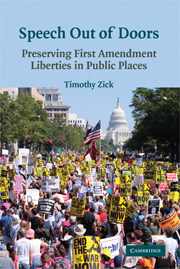Book contents
- Frontmatter
- Contents
- List of Figures
- Preface
- Acknowledgments
- SPEECH OUT OF DOORS
- 1 Introduction: The Geography of Expression
- 2 The Expressive Topography and Public Liberties
- 3 Embodied Places
- 4 Contested Places
- 5 Non-Places
- 6 Inscribed Places
- 7 Militarized Places
- 8 Places of Higher Learning
- 9 Networked Public Places
- Epilogue
- Index
2 - The Expressive Topography and Public Liberties
Published online by Cambridge University Press: 05 June 2012
- Frontmatter
- Contents
- List of Figures
- Preface
- Acknowledgments
- SPEECH OUT OF DOORS
- 1 Introduction: The Geography of Expression
- 2 The Expressive Topography and Public Liberties
- 3 Embodied Places
- 4 Contested Places
- 5 Non-Places
- 6 Inscribed Places
- 7 Militarized Places
- 8 Places of Higher Learning
- 9 Networked Public Places
- Epilogue
- Index
Summary
Today, Americans enjoy greater “parchment” liberties than perhaps at any time in history. As a nation, we espouse and occasionally aspire to “export” a brand of free speech liberalism that is grounded upon the broadest conceptual breathing space for expression. Physical breathing space for public liberties is another matter. The surface area of our expressive topography – the amount of public space that is available for and actually facilitates the exercise of First Amendment liberties – has been drastically shrinking for many decades.
Americans today are not nearly as prone to public displays of contentious politics as, for example, citizens of some European nations. They are not generally inclined to assemble en masse to protest against social and political conditions, demand relief from officials, or present their collective grievances. When they do occur, public demonstrations and protests in this country are generally peaceful and largely institutionalized events. The contemporary American style of public democracy might be considered rather tame and anemic in comparison to, say, that of the French.
It has not always been so. Our expressive topography has been forged by a variety of forces and events from the Revolution to the present day. The American people did not simply and suddenly abandon public places, public life, or their public liberties. Public contention was not institutionalized overnight. The transformation of our expressive topography is a fascinating story, one that has not received nearly the attention it deserves.
- Type
- Chapter
- Information
- Speech Out of DoorsPreserving First Amendment Liberties in Public Places, pp. 25 - 64Publisher: Cambridge University PressPrint publication year: 2008



